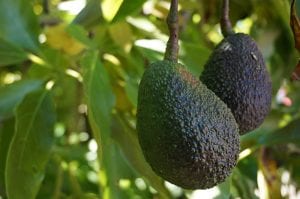
Harvesting the California avocado crop and moving the fruit to market has become increasingly difficult, growers say, citing challenges of soaring water, land and labor costs.
Add the twists and turns of variables such as import competition, market price fluctuations, weather and pests, and it’s been a real roller coaster ride to the packinghouse, they say.
This year’s crop surprised many growers because of its size, according to Ventura County avocado and citrus grower Leslie Leavens.
“The crop this year is way bigger than the one last year, thankfully,” Leavens said, describing the previous crop as “mediocre at best.”
The current crop, she said, showed avocado growers their limitations at estimating their crops beforehand.
“We kept missing fruit buds on the trees and now, as we’re harvesting, we keep finding more and more fruit we didn’t realize was there,” Leavens said.
The previous, 2014-15 avocado crop came in at about 279 million pounds, well short of the “nice sized” crop of 300 million to 350 million pounds growers and packers prefer to see going to market, said Tom Bellamore, California Avocado Commission president.
The official midseason estimate for the current, 2015-16 crop was more than 390 million pounds, and Bellamore said the final crop volume could exceed the estimate.
“We’re fairly well along in our harvest and overall we’re expecting a 400 million pound crop, which is larger than typical,” he said. “We did experience some fruit drop due to heat. Hopefully, we’re past that now.”
Fruit drop during a mid-June heat wave was not significant in terms of reducing the statewide avocado crop across the total production area of 52,000 acres, he said. But for certain regions—Temecula and the De Luz growing area in San Diego County, for example—crop losses were severe, he said.
Noel Stehly, an avocado grower based in Valley Center, said he and other farmers in his part of San Diego County experienced crop loss due to the heat wave, which brought extended days of triple-digit temperatures.
Once the state’s top avocado-producing region, the San Diego area continues to see declines in avocado acreage. In 2009, before the current drought, San Diego County reported more than 19,000 acres planted to avocados, but that number had dropped to about 16,000 acres in 2015.
“There are fewer avocado groves alive in our area because growers have cut off the water,” Stehly said. “Growers can’t afford the water at $1,600 to $1,800 an acre-foot.
“It’s a shame, because there are good groves all around us, but I’m shutting things off,” he added. “I just shut the water off to another 10 acres. I honestly don’t know what I’m going to do in the future.”
Along the Santa Barbara coast, which has also seen a decline in avocado acreage, farmer Paul Van Leer of Goleta said growers who depend on water supplies from Cachuma Lake reservoir through the West Conduit are receiving no water deliveries.
The reservoir, which currently stands at about 14 percent of capacity, headed for dead pool, is the primary water source for about three-quarters of a million people, and provides reservoir releases for species protection that supercede water supply needs of agriculture.
“There’s a lot of (tree) stumping going on in our area right now,” said Van Leer, who is a Santa Barbara County Farm Bureau director. “Growers are tightening their belts; many are picking early. The level of concern about water is high, but there isn’t much we can do about it.”
Like many farmers in the state’s avocado-growing regions, Van Leer lacks access to high quality groundwater. Avocado trees are highly salt-sensitive, and salt levels in many groundwater basins are too high for growing purposes.
To obtain good quality reservoir water, growers in Van Leer’s area are paying $1,800 an acre-foot for water, but aren’t receiving any.
In Ventura County, Leavens said the larger-than-expected avocado crop is being harvested at the same time the farm’s lemon trees are producing a “great crop.” That, she said, has created a shortage of employees, and ripe fruit is dropping to the ground—both avocados and lemons—because of increased demand for picking crews.
“We knew coming into this year the avocado crop would be better than last year and we knew the lemon crop would be strong,” she said. “We figured we’d be in trouble if we didn’t have enough workers.”
Leavens Ranches decided last year to participate in the federal H-2A agricultural guestworker program, and bought a small apartment building in the Santa Paula Valley to house employees for the 2016 season. But even with an augmented workforce, she said, crews can’t keep up.
“Our labor contractor said his phone is ringing off the hook with calls for crews,” Leavens said. “It’s really something.”
Although there have been challenges with this year’s crop and some avocado growers are struggling, Bellamore said he expects a good-sized, good-quality California crop.
Mexican exporters tapered off their supplies and concluded harvest earlier than usual, leaving a supply gap that pushed avocado farmgate prices up more than 30 cents a pound between mid-June and July.
“Right now the market is good,” Bellamore said. “Demand is very strong. The last fruit being harvested now will clearly benefit from the positive market conditions.”
Kate Campbell is an assistant editor of Ag Alert. She may be contacted at kcampbell@cfbf.com.Permission for use is granted by the California Farm Bureau Federation.










